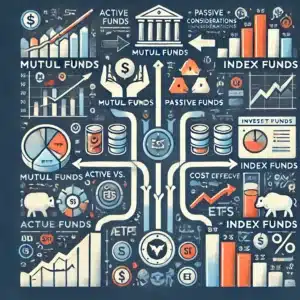Investment Funds: Types and how to choose the best one for your profile.

Anúncios
Definition and Purpose of Investment Funds
Investment funds are pooled funds from various investors that are professionally managed to achieve specific financial objectives. The purpose of investment funds is to provide individuals with access to a diversified portfolio of securities that they might not be able to afford or manage on their own.
Benefits of Investing in Funds vs. Individual Securities
Investing in funds offers diversification, professional management, and access to a variety of assets, reducing risk compared to investing in individual securities. Additionally, funds provide liquidity, economies of scale, and the opportunity to invest in markets that may be inaccessible to individual investors.
Overview of the Investment Fund Landscape
The investment fund landscape encompasses a wide range of options, including mutual funds, exchange-traded funds (ETFs), and index funds. Each type of fund has its unique characteristics, advantages, and considerations for investors seeking to build a well-rounded investment portfolio.
Anúncios
Types of Investment Funds
Mutual Funds: Actively Managed, Diversified Portfolios
Mutual funds are investment vehicles managed by professionals that collect money from various investors to buy a diverse portfolio of stocks, bonds, and other securities. These funds are actively managed by professional fund managers who make investment decisions based on the fund’s objectives. Investors benefit from diversification and expertise without having to actively manage their investments.
Exchange-Traded Funds (ETFs): Traded Like Stocks, Often Track Indexes
ETFs are similar to mutual funds but are traded on stock exchanges like individual stocks. They typically track specific indexes, sectors, or commodities.ETFs provide liquidity, transparency, and typically have lower expense ratios compared to mutual funds. Investors can buy and sell ETF shares at market prices throughout the trading day.Investors can buy and sell ETF shares at market prices throughout the trading day.Investors can buy and sell ETF shares at market prices throughout the trading day.
Index Funds: Passive Management, Low-Cost Option
Index funds are passively managed funds that aim to replicate the performance of a specific market index, such as the S&P 500. These funds have lower management fees due to their passive nature and often outperform actively managed funds over the long term. Index funds are a cost-effective way to gain exposure to broad market segments.
Anúncios
| Fund Type | Key Features | Risk Level |
|---|---|---|
| Mutual Funds | Actively managed, diversified portfolio | Moderate to high |
| Exchange-Traded Funds (ETFs) | Traded like stocks, tracks indexes | Moderate |
| Index Funds | Passively managed, replicates market index | Low to moderate |
Understanding Risk and Return Profiles
Importance of Risk Tolerance Assessment
Assessing your risk tolerance is crucial when selecting an investment fund. Understanding how much risk you can handle emotionally and financially helps in choosing a fund that aligns with your comfort level.
Relationship between Risk and Potential Returns
Risk and potential returns go hand in hand in the world of investments. Higher-risk funds often offer the potential for higher returns, while lower-risk options typically come with more conservative growth prospects.
Volatility and Its Impact on Investment Stability
Volatility, the fluctuation in an investment’s value, can impact the stability of your portfolio. Funds with higher volatility may experience larger price swings, potentially affecting your overall investment stability.
Aligning Investment Objectives with Personal Financial Goals
When choosing an investment fund, it’s crucial to align your investment objectives with your personal financial goals. Consider whether you are investing for retirement, saving for a major purchase, or seeking long-term growth. By matching your goals with the fund’s investment strategy, you can ensure that your money is working towards achieving your specific financial aspirations.
Evaluating Fees, Expenses, and Their Long-Term Impact
Another key factor to consider is the fees and expenses associated with the investment fund. High fees can significantly eat into your returns over time, so it’s important to evaluate the total cost of investing in a particular fund. Look for funds with competitive fees that offer value for the services provided.
Assessing Fund Manager Expertise and Track Record
Assessing the expertise and track record of the fund manager is essential in making an informed decision. A knowledgeable and seasoned fund manager can greatly influence the fund’s performance. Look into the manager’s investment approach, past performance, and consistency in delivering returns relative to the fund’s objectives.
Diversification Strategies Within Investment Funds
Importance of Diversification in Risk Management
Diversification is crucial in spreading risk across different assets to minimize potential losses. By investing in a variety of securities, you can reduce the impact of a single investment’s poor performance on your overall portfolio.
How Different Fund Types Achieve Diversification
- Mutual Funds: These funds collect money from numerous investors to invest in a diversified portfolio of stocks, bonds, or other securities.
- Exchange-Traded Funds (ETFs): ETFs offer diversification by tracking indexes or specific sectors, allowing investors to access a wide range of assets.
- Index Funds: These funds replicate the performance of a specific index, providing instant diversification across a broad market.
Balancing Diversification Across Asset Classes and Sectors
Balancing diversification involves spreading investments across various asset classes like stocks, bonds, real estate, and sectors such as technology, healthcare, and energy. This ensures that your portfolio is not overly exposed to the risks of a single asset class or sector.
Researching and Evaluating Investment Funds
Key Performance Metrics to Consider
When evaluating investment funds, key performance metrics play a crucial role in making informed decisions. These metrics provide valuable insights into the fund’s historical performance and can help investors assess potential future outcomes. Some essential performance metrics to consider include:
- Annualized Return: This metric showcases the average annual return of the fund over a specific period, providing a clear picture of its past performance.
- Expense Ratio: The expense ratio represents the percentage of the fund’s assets deducted annually to cover operating costs. Lower expense ratios are generally favorable for investors.
- Sharpe Ratio: The Sharpe ratio measures the risk-adjusted return of the fund, helping investors understand how much return they receive for the level of risk taken.
Using Fund Prospectuses and Fact Sheets
Fund prospectuses and fact sheets are valuable sources of information for investors looking to research and evaluate investment funds. Prospectuses contain detailed information about the fund’s objectives, strategies, risks, and historical performance. On the other hand, fact sheets offer concise summaries of key fund details, making it easier for investors to compare different funds quickly. It is essential to review these documents carefully to gain a comprehensive understanding before making investment decisions.
Leveraging Online Research Tools and Financial Advisors
In today’s digital age, online research tools have made it easier for investors to analyze and compare investment funds. Websites, such as Morningstar and Yahoo Finance, provide fund performance data, ratings, and reviews that can assist in decision-making. Additionally, seeking guidance from financial advisors can offer personalized recommendations based on individual financial goals and risk tolerance. Their expertise can help investors navigate the complexities of the investment landscape and make well-informed choices.
Matching Funds to Your Financial Goals and Risk Appetite
Assessing Your Investment Time Horizon
When considering investment funds, it’s crucial to evaluate your investment time horizon. Are you saving for retirement in 30 years or planning to buy a house in the next five? Understanding your time frame helps determine the appropriate level of risk you can take on and the potential returns you might expect. Short-term goals may require more conservative funds, while long-term objectives could tolerate higher-risk options for potentially greater gains.
Balancing Short-Term and Long-Term Financial Objectives
Balancing short-term and long-term financial goals is key when matching funds to your profile. While short-term needs like emergencies or upcoming expenses should be considered, it’s equally important to prioritize long-term objectives such as retirement savings or wealth accumulation. Allocating funds accordingly can help achieve a healthy balance between immediate liquidity and future growth.
Adjusting Fund Choices as Your Risk Tolerance Changes
As life circumstances evolve, so too can your risk tolerance. It’s essential to periodically reassess your comfort level with risk and adjust your fund choices accordingly. Whether due to changes in income, family responsibilities, or market conditions, staying in tune with your risk appetite ensures that your investment portfolio remains aligned with your financial goals and overall comfort level.
Tax Implications and Regulatory Considerations
Understanding Tax Efficiency
When considering different types of investment funds, it’s crucial to understand their tax efficiency. Some funds, like tax-exempt municipal bond funds, offer tax advantages by providing income that is typically exempt from federal taxes. On the other hand, taxable bond funds may have tax implications that need to be taken into account when evaluating their overall return on investment.
Regulatory Protections for Investors
Investors can benefit from regulatory protections that govern the operations of investment funds. These regulations are designed to safeguard investor interests, promote transparency, and ensure fair practices within the financial industry. By adhering to regulatory guidelines, investment funds provide a level of security and trust for investors.
Importance of Transparency and Reporting
Transparency and reporting play a vital role in maintaining investor confidence. Investment funds are required to disclose essential information regarding their performance, holdings, fees, and risks to investors through regular reports and prospectuses. This transparency enables investors to make informed decisions based on reliable data.
Conclusion: Making Informed Investment Fund Decisions
Recap of Key Factors in Fund Selection
- Aligning investment objectives with personal financial goals is crucial.
- Evaluating fees, expenses, and their long-term impact helps in maximizing returns.
- Assessing fund manager expertise and track record ensures competent management.
Importance of Ongoing Portfolio Review and Rebalancing
Regularly reviewing your investment portfolio is crucial to ensure it aligns with your financial goals and risk tolerance. Rebalancing involves adjusting your asset allocation to maintain desired risk levels and potential returns. This practice helps in staying on track with your investment objectives over time.
Encouraging Further Education and Professional Advice When Needed
Continuing to educate yourself about investment funds and financial markets is key to making informed decisions. Seeking advice from financial professionals can provide valuable insights and guidance, especially when navigating complex investment options or regulatory considerations.







